Tiktok Cross-Border E-Commerce: A Guide to Enter China Market
OctoPlus Media released a whitepaper offering strategies for Cross-Border E-commerce to tap into China market, focusing on Tiktok (Douyin) to drive sales and brand growth.
Unlocking Success in the China Market with Tiktok (Douyin) Cross-Border E-Commerce!
OctoPlus Media studied the China market and the Douyin cross-border e-commerce, and released a professional whitepaper that provides an in-depth analysis on how to quickly enter the Chinese market through platforms such as Tktok (Douyin). This whitepaper covers the latest trends in cross-border e-commerce, market opportunities, successful case studies, and practical strategies for overseas brands, helping them effectively tap into China’s consumer behavior and achieve both sales growth and increased brand influence.
Why Are Overseas Brands Choosing China Market?
The appeal of the Chinese cross-border e-commerce market lies primarily in two key factors: its massive population base and strong purchasing power. According to data from Statista, the National Bureau of Statistics, China Business Network, expert interviews, and 36Kr Global Research, Douyin’s cross-border e-commerce is expected to achieve an average growth rate of 82% over the next three years. The Chinese market is in a rapid growth phase, providing an excellent opportunity for overseas brands to seize market share. In addition, both government policies and platform initiatives are supporting cross-border e-commerce, further driving the sector’s development.
1. Global Cross-Border E-Commerce Market Data and Trends
Cross-border e-commerce has become a crucial connection point between global consumers and brands, showcasing immense market potential:
- The global cross-border B2C e-commerce market reached approximately $1.5 trillion in 2023, highlightingthe huge global consumer potential.
- In 2022, the global cross-border e-commerce consumer penetration rate was about 20.3%, with consumers purchasing goods via cross-border e-commerce platforms.
- The global cross-border B2C e-commerce market is projected to grow by around 25% in 2023, indicating a strong trend of market expansion.
2. The Potential of the China Market
As the world’s largest online retail market, China has shown particularly outstanding performance in cross-border e-commerce. Chinese consumers’ demand for imported products continues to rise, fueling the strong growth of cross-border e-commerce. Key data points about the China market include:
- 1 billion internet users: China boasts the world’s largest internet user base, with the expanding online retail market offering a broad consumer foundation for cross-border e-commerce.
- 168 million consumers: By 2023, China’s cross-border e-commerce user base will reach 168 million, reflecting strong consumer demand for international products.
- $9.52 trillion: In 2022, China’s total consumer spending reached $9.52 trillion, ranking second globally and highlighting the immense purchasing power of Chinese consumers.
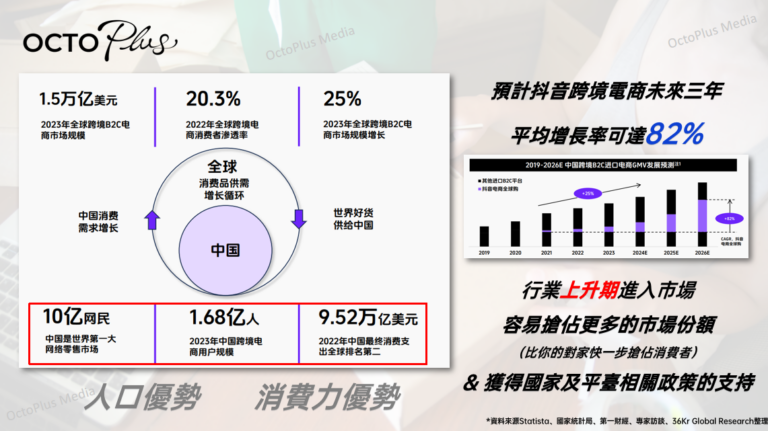
(Data from Statista, the National Bureau of Statistics, China Business Network, expert interviews, and 36Kr Global Research)
Core Advantages of the Cross-Border B2C Model
Compared to traditional import trade and domestic stock models, cross-border B2C e-commerce shows significant advantages. Traditional import trade often involves multiple intermediaries and high costs, resulting in a loss of price competitiveness in the Chinese market. Meanwhile, the domestic stock model, though faster, frequently relies on purchasing agents, which may involve illegal customs clearance and make it difficult to verify product authenticity, leading to lower consumer trust.
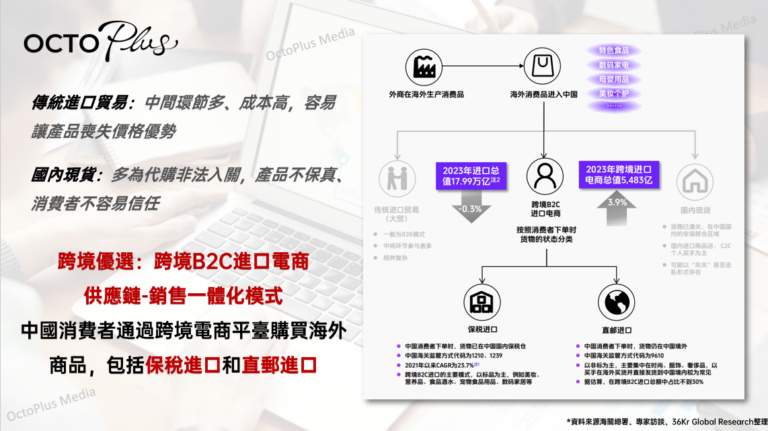
Cross-border e-commerce platforms, supported by national policies and platform certifications, offer overseas brands an integrated solution from supply chain management to sales, overcoming many drawbacks of traditional models. The core advantages include:
- Lower Tax Burden: National policies for cross-border e-commerce reduce the tax pressure on imported goods. Especially through bonded zone models, product price competitiveness is further enhanced.
- Efficient Supply Chain Integration: Platforms ensure supply chain security and transparency through certification mechanisms, reducing intermediaries and guaranteeing the authenticity of products. Compared to domestic stock reliant on purchasing agents, the cross-border e-commerce model is more likely to gain consumer trust.
- Strong Platform Traffic: Platforms like Douyin, with 600 million daily active users, offer brands the opportunity to leverage massive traffic, rapidly expanding their exposure and reaching a broader target audience.
Chinese Market Trends and Opportunities
Currently, several key shifts in consumer behavior are emerging in the Chinese market. Brands need to align their cross-border e-commerce strategies with these trends to seize market opportunities.
Trend 1: The Era of Consumption Upgrading
We are in an era of consumption upgrading, where consumer demands across all segments are becoming increasingly differentiated.
- Top-tier consumers: Value emotional appeal and are willing to pay for products that reflect personal identity or resonate emotionally.
- Mid-tier consumers: Focus on the practical effiencyof products and tend to choose items with high cost-effectiveness and standout performance.
- Entry-level consumers: Prefer high-quality alternative products that offer great value for money, aiming for cost-effectiveness.

Trend 2: The Rise of Specific Products Category
Consumers are increasingly seeking personalized imported products:
- They prefer products that meet specific needs.
- They are no longer satisfied with traditional mass-market products, instead looking for items that precisely match their health requirements, age group, or specific lifestyle scenarios.
- This is particularly evident in categories like maternal and infant products, and dietary supplements.
- Consumers pay attention to the professionalism and specialization of the products.
Brands and merchants are actively exploring niche markets:
- They are launching more specialized and innovative products.
- This helps to cater to the increasingly diverse demands of consumers.
Trend 3: Interest-Driven Consumption
Consumer Behavior Analysis:
- Consumers first seek to understand the origin, brand philosophy, and other background information about the product.
- In cross-border e-commerce, they focus not only on the product itself but also the story behind it.
Interest-Driven Consumption Trend:
- Brands leverage KOLs (Key Opinion Leaders), KOCs (Key Opinion Consumers), and TVC (Television Commercial) promotions to tell brand stories and highlight product value.
- This effectively increases consumers’ desire to purchase and fosters loyalty.
- Consumers are willing to pay for a brand’s philosophy or values.
Trend 4: Authentic, Filter-Free Shopping Experience
As consumers become more rational and mature, they increasingly value authentic, filter-free shopping experiences:
- About 72% of Chinese consumers believe that real feedback and reviews are crucial to their purchasing decisions.
In cross-border e-commerce, the following strategies help to build consumer trust and drive conversions:
- Live Streaming Product Demonstrations
- User Reviews
- Authentic Content Reviews from KOLs and KOCs
This trend indicates that brands need to ensure transparency and efficiency in product quality, logistics, and after-sales service to meet consumers’ growing demand for authenticity.
*The whitepaper will showcase the four major trends shaping changes in consumer behavior in the Chinese market.
Cross-Border E-Commerce Consumption Trends
With the upgrading of consumption and increasing segmentation of demand in the Chinese market, cross-border e-commerce categories such as nutritional supplements, maternal and baby care, beauty and personal care, and apparel and accessories are experiencing significant growth trends.
1. Nutritional Supplements:
As health awareness among Chinese consumers continues to rise, the demand for nutritional supplements is becoming more segmented. Consumers are no longer satisfied with general-purpose supplements; instead, they prefer personalized nutritional solutions tailored to their specific health needs. Due to the superior quality and production processes of foreign brands, 46% of Chinese consumers prefer imported dietary supplements that address specific health concerns. These products, featuring advanced ingredients and cutting-edge technology, are gaining popularity by meeting the modern consumer’s demand for personalized health management.
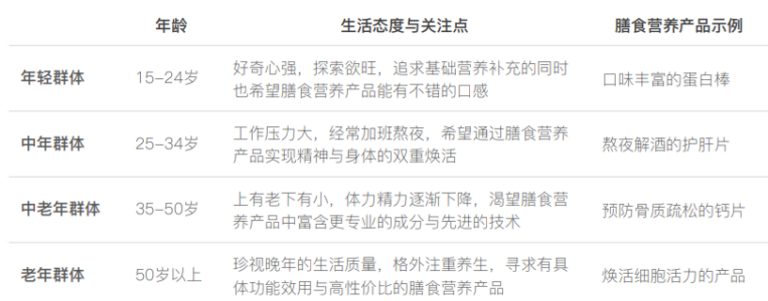
2. Maternal and Baby Care:
With the continuous evolution of parenting philosophies, Chinese consumers have become more stringent in their demands for maternal and baby products. Approximately 40% of Chinese infants experience allergies, driving demand for additive-free products. Overseas brands, known for their rigorous quality standards, have gained the trust of Chinese parents. In fact, 43% of consumers prefer maternal and baby products with patented ingredients to ensure the safety and health of their children. This focus on safety and professionalism has fueled the growth of imported maternal and baby products in the market.
3. Beauty and Personal Care:
Consumers in the beauty and personal care segment are increasingly prioritizing ingredient safety and environmental sustainability. A significant 57% of Chinese consumers have high expectations for beauty products’ ingredients, leaning toward plant-based, safe, and non-irritating products. Additionally, the scarcity and personalization of region-specific limited editions from overseas brands attract consumers seeking a unique beauty experience.
4. Apparel and Accessories:
For Chinese consumers, buying apparel and accessories is no longer just about functionality, but also about emotional value and fashion appeal. With the rise of outdoor activities, the demand for personalized and niche apparel has significantly increased. Brands are collaborating with fashion influencers and utilizing short videos and live streaming to showcase the latest fashion trends, meeting consumers’ desire for stylish and trendy items. Apparel and accessories have become more than just practical goods; they are symbols of personal style and attitude.
Understanding Cross-Border E-Commerce Consumers
1. User Demographics:
- Primary User Groups:
- Emerging white-collar professionals aged 25-35
- Young people from towns
- Characteristics:
- These users have relatively strong purchasing power and are accustomed to discovering new products through social media.
- They prefer discovering products naturally through interest-driven content and making purchases based on those recommendations.
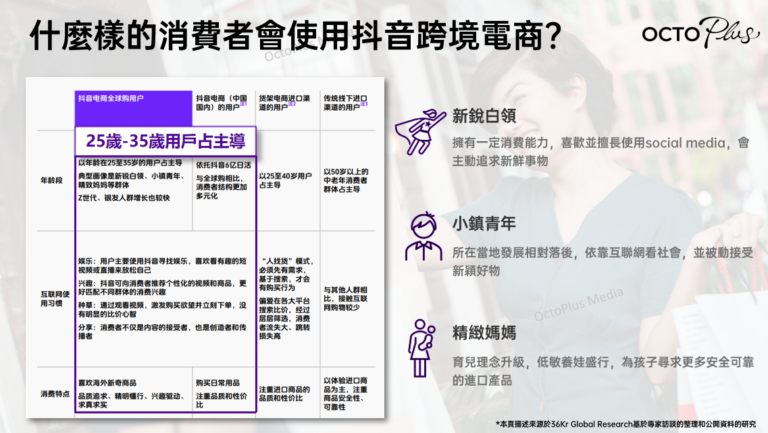
2. High-Demand Products:
- Beauty and Personal Care Products: Have the highest penetration rate and are the top choice for consumers.
- Sports, Outdoor, and Nutritional Supplements: Around 50% of consumers plan to increase their spending in these categories in the future.
- Korean and Japanese Beauty and Personal Care Products: Meet the specific needs of Asian skin, making them highly favored.
- Australian and New Zealand Maternal, Baby, and Nutritional Products: Recognized for their strict safety standards, gaining strong consumer trust.
3. Analysis of Chinese Consumer:
- Wealthy but Selective: Consumers have strong purchasing power but are highly discerning when it comes to product selection.
- Pursuit of Unique Products: They show great interest in innovative and unique products.
- Focus on Quality: High expectations for product quality and reliability.
- Value for Money: They seek products that offer high quality at reasonable prices.
- Personalization: Consumers prefer products that reflect their personal style and identity.
- Desire for Authentic Experiences: They value genuine product feedback, especially through live streaming and user reviews.
- Emotional Value: Consumers are particularly drawn to brands or products that evoke emotional resonance.
- High Expectations for Logistics: They expect fast, safe delivery of products.
Core Strategies of Douyin Cross-Border E-Commerce
1. Breaking Traditional E-Commerce Models
- “Product Finds Consumer” Innovation: The core strategy focuses on an innovative model where products are recommended to consumers based on their interests and content engagement.
- Interest and Content-Driven: Consumers discover products organically while watching content, creating demand naturally and reducing the need for price comparisons.
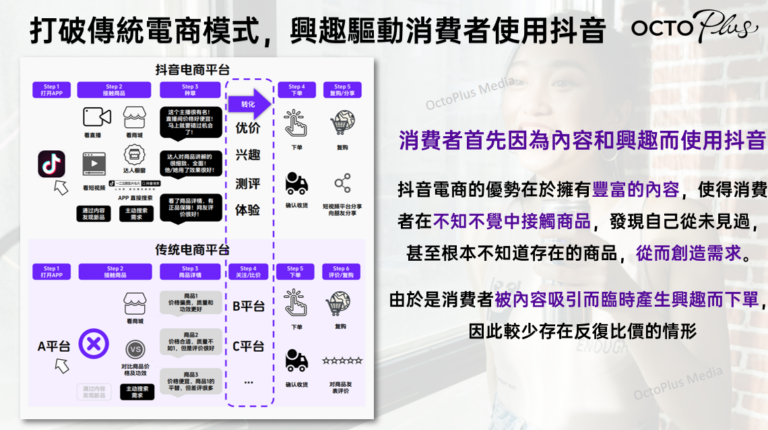
2. People-Location-Product Strategy
- Comprehensive Marketing Coverage: Encompasses all promotional scenarios, including live streaming, KOL (Key Opinion Leader) collaborations, search, e-commerce stores, and brand advertisements.
- Consistent Brand and Pricing Strategy: Ensures that consumers receive a consistent shopping experience, regardless of the channel through which they engage with the brand.
Three-Stage Strategy for Douyin Cross-Border E-Commerce
1. Incubation and Growth Phase
- Establish a dedicated team and livestream space while steadily growing a fan
- Use influencers and content-driven marketing to lay the foundation for the brand.
2. Rapid Growth Phase
- Boost brand and product exposure through short videos and influencer-driven sales.
- Increase Brand Promotionto quickly penetrate the market.
3. Stable Operations Phase
- Use brand-led livestreams to maintain consistent operations.
- Further boost GMV (Gross Merchandise Value) by participating in large-scale livestreaming events.
Douyin Audience Strategy Overview: 600 Million Daily Active Users
- Precise Targeting: Utilizing big data to accurately identify and segment users, from passive exposure to repeat purchasers, ensuring a tiered promotional approach.
- Operational Optimization: Regularly updating content and refining operations to ensure a seamless user experience, from initial engagement to final purchase.
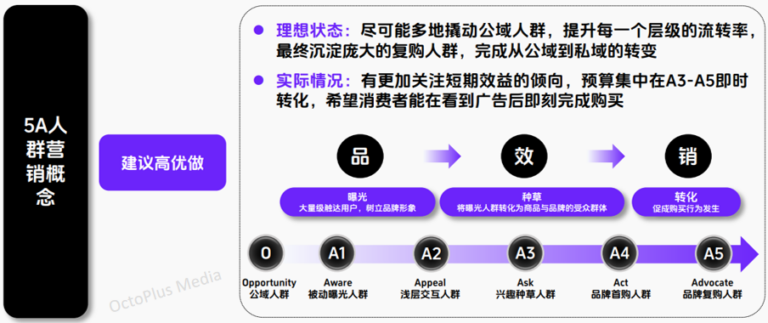
Case Study: Overseas Brands Entering Douyin Cross-Border E-Commerce
1. KANEBO: A well-known Japanese cosmetics brand under Kao Corporation, headquartered in Tokyo. KANEBO focuses on beauty and skincare products, with an emphasis on innovation and high-quality product development, making it highly popular among consumers.
- Collaborate with KOLs: Partnered with top Key Opinion Leaders (KOLs) to create brand awareness and product buzz through consistent content seeding and livestreaming activities.
- Test Marketing: Conducted market testing before product launches to gather consumer feedback and adjust strategies.
- Targeted Gen Z Consumers: Focused on capturing the Gen Z demographic by setting up the brand’s dedicated livestreaming room.
- Extended Livestream Durations: Each livestream lasted a minimum of 3 hours to maximize brand exposure and increase visibility.
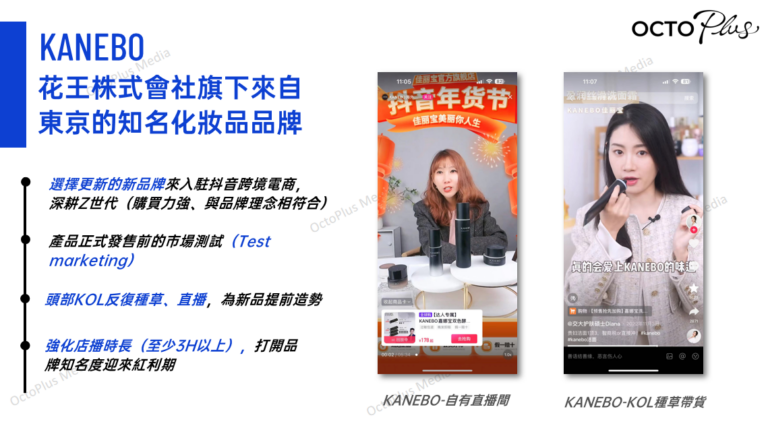
2. SHEVEU: A scalp health care brand from Australia. SHEVEU focuses on developing scalp care products, earning consumer trust through its high-tech ingredients and strict production standards.
- Using Douyin’s Three-Stage Strategy: SHEVEU followed Douyin’s three-phase strategy, progressing from the incubation phase of fan accumulation to the rapid growth phase for market expansion, and finally into the stable operations phase.
- Precise Audience Targeting: Positioned the brand by leveraging the image of scalp care experts to build consumer trust.
- KOL Collaboration: Partnered with Key Opinion Leaders (KOLs) for livestream sales, continuously refining livestream scripts, and focusing on single products to create best-sellers.
- 5A Audience Strategy: Utilized Douyin’s 5A audience strategy to continually acquire new customers while increasing fan loyalty.

3.Cathay Asia Miles: A premium loyalty program launched by Cathay Pacific, targeting high-net-worth individuals in the Greater Bay Area and mainland China.
- Attracting High-Spending Users: Leveraged livestreaming and full-scale e-commerce promotion to attract users with strong purchasing power to join the membership program.
- Promoting Lifestyle Concepts: Focused on high-net-worth individuals in the Greater Bay Area and major cities, using brand-led livestreams to promote the concept of a premium lifestyle.
- Douyin Mall and Livestreaming for User Acquisition: Used Douyin’s e-commerce features and livestreaming to drive traffic, continuously attracting new users and expanding the market.

Get Our Exclusive Whitepaper Now to Enter China’s E-Commerce Market!
This article has highlighted the key strategies for cross-border e-commerce brands to successfully enter the Chinese market via Douyin, emphasizing the growing consumer demand for personalized and authentic shopping experiences. Brands must leverage precision marketing and KOL/KOC promotions to tell compelling product stories that drive consumer desire. Additionally, ensuring transparency and efficiency in product quality, logistics, and after-sales service is crucial.
If you’re looking to learn more about proven strategies and practical experience for success in the China market, feel free to leave your details below. We will send you the “Cross-Border E-Commerce: A Comprehensive Guide to Enter China Market“ whitepaper, helping your brand quickly capture the attention of Chinese consumers!

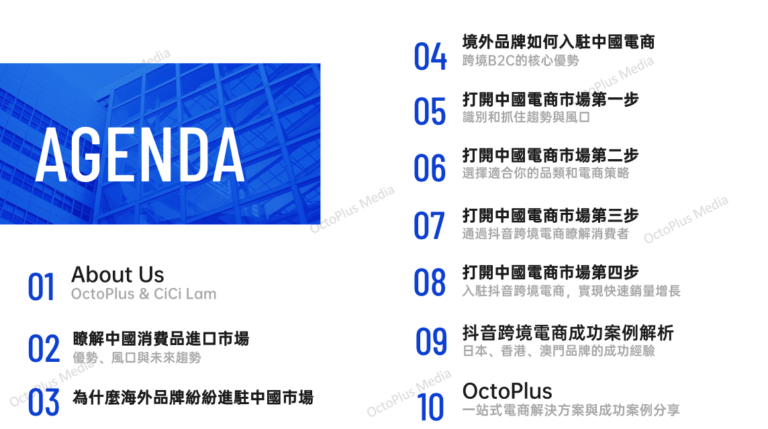
Feel free to talk to us
It’s a team with one single shared goal, which is our client’s success. Deliver results for your business now.
































